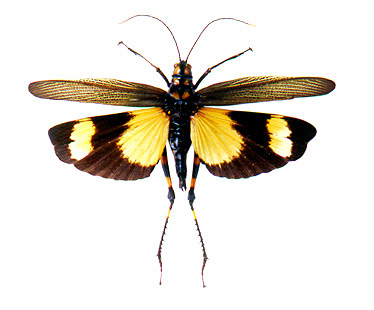
Orthoptera - The Grasshoppers, Crickets and Katydids
The order Orthoptera contains the familiar grasshoppers, locusts, crickets, and katydids. The name "Orthoptera" is derived from the Greek words for “straight-wing”. The ancestors of the Orthoptera share a common lineage with cockroaches; their origins go back to the Carboniferous period some 345-280 million years ago. The earliest fossils found so far date from about 300 million years ago. Orthopterans exhibit incomplete metamorphosis, meaning that the newly hatched nymphs resemble tiny versions of the adults. Amongst the crickets, nymphs will very often be tiny, wingless versions of the adults but amongst the grasshoppers, nymphs are often brightly colored with bold patterns that do not resemble the adults colors. This is to advertise their toxicity (the result of feeding on poisonous plants) to predators. Orthopterans are an interesting group with well over 20,000 described species. Many are well-known for their sound-producing capabilities and the order also contains some of the largest insects. A few of the massive Orthopterans that inhabit the world, many unchanged since the days of the Dinosaurs, are: giant wetas weighing 70 grams, giant katydids as big as a human hand, giant grasshoppers with 12” wingspans (30cm). Given the amazing variety of forms scientists have broken them down into two Suborders: Caelifera and Ensifera.
Caelifera - The Grasshoppers
Known as grasshoppers and locusts, members of the suborder Caelifera are recognizable by their short, thick antennae and the location of their sound producing apparatus. Minute pegs on the hind femora (the large part of the back legs) are scraped against prominent, hardened veins on the forewings to produce sounds. Grasshoppers, aside from being a sweet, alcoholic beverage popular in the 1920's, are insects best known for their consumption of vegetation. Let it be know that locusts are grasshoppers. However, not all grasshoppers are locusts. Locusts are grasshoppers that occur in two distinct phases: solitary and gregarious. Only a few species of grasshoppers are capable of this transformation. In some species, the change is so drastic that the two forms were once mistaken for different species. It takes the right set of conditions for these unusual grasshoppers to become locusts. Typically, parallel increases in both the grasshopper population and the plants that are their food sets the stage for a locust swarm. As the population increases, the successive generations will begin to look and act different from their parents. These normally solitary grasshoppers interact more and as when mature, become a gregarious aggregation of young locusts. Locusts still strike fear in developing countries where swarms of them can denude the Earth.
 Northern Spotted Grasshopper (Aularches miliaris = punctatus)
Northern Spotted Grasshopper (Aularches miliaris = punctatus)
 Carolina Locust (Dissosteira carolina)
Carolina Locust (Dissosteira carolina)
 Grasshopper (Lophacris cristata)
Grasshopper (Lophacris cristata)
 Differential Grasshopper (Melanoplus differentialis)
Differential Grasshopper (Melanoplus differentialis)
 Robust Toad-hopper AKA Toad Lubber Grasshopper (Phrynotettix robustus)
Robust Toad-hopper AKA Toad Lubber Grasshopper (Phrynotettix robustus)
 Grasshopper (Phymateus saxosus)
Grasshopper (Phymateus saxosus)
![]() Southeastern Lubber Grasshopper (Romalea guttata)
Southeastern Lubber Grasshopper (Romalea guttata)
 Giant Grasshopper (Tropidacris dux)
Giant Grasshopper (Tropidacris dux)
Ensifera - The Crickets
Comprised of those insects known as crickets and katydids, members of the suborder Ensifera are distinguished by their long, filamental antennae, often many times the length of the insect itself. The females of this suborder are conspicuous by having a long ovipositor projecting from the end of their abdomen. The males are unique for making their music by rubbing together their forewings, which are modified for this purpose. Ridges on one forewing are rubbed against the scraper on the opposing forewing to produce sounds unique to each species. These insects are frequently nocturnal and can often be heard calling from trees and bushes on late summer nights. Captivating for their songs (particularly crickets), they are frequently kept as pets.
 Giant Tobacco Cricket (Brachytrupes membranaceus)
Giant Tobacco Cricket (Brachytrupes membranaceus)
 Camel Cricket (Ceuthophilus sp.)
Camel Cricket (Ceuthophilus sp.)
 Vietnamese Fighting Cricket (Gryllus bimaculatus)
Vietnamese Fighting Cricket (Gryllus bimaculatus)
 Giant Katydid (Macrolyristes sp.)
Giant Katydid (Macrolyristes sp.)
 Roesel's Katydid (Metrioptera roeselii)
Roesel's Katydid (Metrioptera roeselii)


